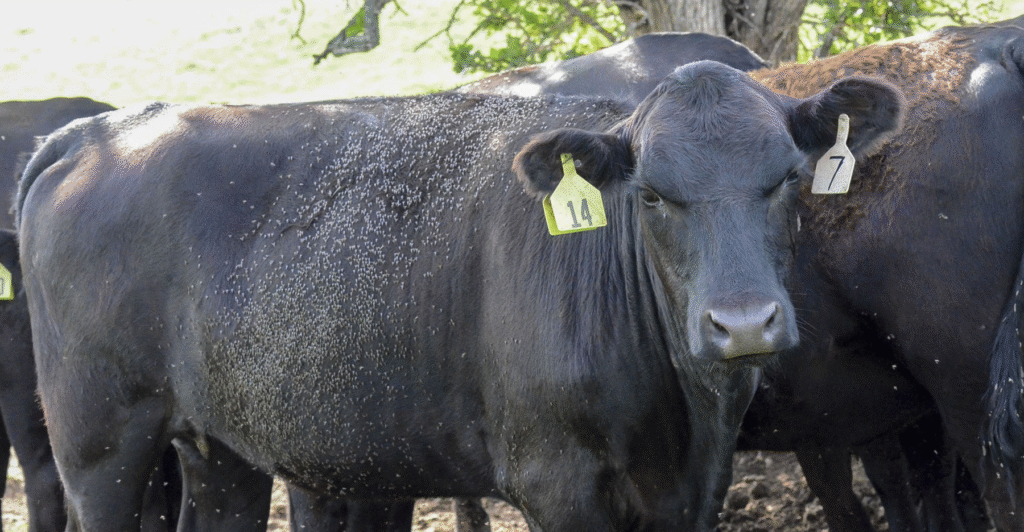
Summer heat brings more than just pasture growth—it also kicks fly season into high gear. For cattle producers in Southeast Georgia, flies can mean lost performance and rising health costs. Horn flies, in particular, are aggressive pests that feed on cattle 20–30 times a day. Left untreated, a single cow can carry up to 1,000 flies. This constant irritation leads to reduced feed efficiency, lower weight gains, and greater disease risk. For nursing calves, disrupted feeding can also mean slowed growth.
Controlling flies takes a well-rounded strategy. Cultural practices like pasture rotation and manure management can limit breeding sites. Mechanical tools like back rubbers and dust bags offer hands-free protection, while chemical options—sprays, pour-ons, and insecticidal ear tags—provide immediate relief.
One of the most effective long-term tools is the use of feed-through insect growth regulators (IGRs). Products containing (S)-methoprene, like Altosid®, pass through the animal and into the manure, where they stop horn fly larvae from developing. Since horn flies lay eggs only in fresh manure, IGRs help break the life cycle at its source.
IGRs work best when started early—about 30 days before flies emerge—and used consistently through the season. Because they don’t kill adult flies, it’s smart to pair them with early-season chemical treatments to reduce existing populations.
Common Chemical Control Options for Adult Flies
To effectively manage resistance and extend product efficacy, rotate between different classes of insecticides. Here are the main groups used for cattle fly control:
🟦 Pyrethroid-Based Products
(Fast knockdown, short residual – resistance common in some regions)
- Pour-Ons:
- CyLence® (cyfluthrin)
- Ultra Boss® (permethrin + piperonyl butoxide)
- StandGuard® (zeta-cypermethrin)
- Clean-Up™ II (permethrin + diflubenzuron IGR)
- Sprays:
- Permectrin II® (permethrin)
- Ectiban®
- Ear Tags:
- Python®, Warrior™, Cylence®
🟧 Organophosphate-Based Products
(Longer residual, slower knockdown – effective against pyrethroid-resistant flies)
- Pour-Ons and Dusts:
- Co-Ral® (coumaphos)
- DeLice® (phosmet)
- Ear Tags:
- Corathon® (coumaphos + cyfluthrin – dual mode)
- Ethion® tags
🟩 Macrocyclic Lactones (Endectocides)
(Internal parasite control + moderate fly suppression)
- Pour-Ons:
- Ivomec® Pour-On (ivermectin)
- Dectomax® (doramectin)
- Eprinex® (eprinomectin – zero milk withdrawal)
These are systemic treatments, absorbed into the bloodstream and excreted through the skin and feces, providing some reduction in horn fly numbers—though not a stand-alone solution for heavy infestations. They also help manage lice, mites, and grubs.
⚠️ Important: Overuse of ivermectin-type products can contribute to parasite resistance. Use judiciously and rotate with other fly control methods for best results.
Flies aren’t just a nuisance—they’re a costly threat to cattle health and productivity. A sound fly control plan, especially one built around consistent IGR use, can help keep your herd comfortable and on track. For help building a strategy that fits your operation, reach out to your local UGA Extension office.
Cited Sources
University of Georgia Integrated Pest Management. (2021). Cattle Horn Fly Management Guide. Retrieved from https://ipm.uga.edu/files/2021/08/Cattle-Horn-Fly.pdf
Townsend, L. (n.d.). Horn Flies on Cattle (ENTFACT-504). University of Kentucky Entomology. Retrieved from https://entomology.ca.uky.edu/ef504
University of Georgia Extension. (2024). Georgia Pest Management Handbook: Livestock and Forages – Special Bulletin 28. Retrieved from https://extension.uga.edu/publications/detail.html?number=SB28
Texas A&M AgriLife Extension. (n.d.). External Parasites on Beef Cattle. Retrieved from https://agrilifeextension.tamu.edu/library/wildlife-nature/external-parasites-on-beef-cattle/
Oklahoma State University Extension. (n.d.). External Parasite Control for Cattle (ANSI-5032). Retrieved from https://extension.okstate.edu/fact-sheets/external-parasite-control-for-cattle.html
Wellmark International. (n.d.). Altosid® Insect Growth Regulator for Horn Fly Control. Retrieved from https://www.centralflycontrol.com
Product Labels: Bayer, Merck, Elanco Animal Health. (n.d.). Livestock Fly Control Product Guides and Specimen Labels.
- CyLence®, Ultra Boss®, StandGuard®, Ivomec®, Dectomax®, Eprinex®, Corathon®